MTH Electric Trains
7020 Columbia Gateway Drive
Columbia MD, 21046
Price $749.95
Website: www.mthtrains.com
1:32 scale, gauge 1, plastic and metal GE Dash 8 diesel locomotive; analog DC, AC, DCC, and MTH DCS-compatible control. Dimensions: length, 26″ (excluding couplers); width, 4″, height, 57⁄8″. In 1:32 scale, this works out to 69’4″ x 10’8″ x 15’8″, respectively
Pros: Correct scale/gauge combination; well detailed with good fidelity to the prototype; multi-protocol operation; good quality sound; crisp paint; strong-pulling locomotive; smooth operation throughout speed range
Cons: Operation on analog PWM DC inconsistent; no way to trigger bell or horn sounds under DC control
GE’s Dash 8 series ushered into prominence one other face of modern railroading—the “wide-nose” or “safety” cab. As the name implies, the wide-nose version has a cab whose nose extends the full width of the frame (tack a “W” onto the end of the name to indicate a wide-nose cab). From the mid 1980s to the mid 1990s, more than 1,500 of these locomotives were built for railroads across the country (and for export) in a variety of axle, cab, and horsepower configurations. Horsepower ranged from 3,200 to 4,400 over the life of the production run. Ultimately, the Dash 8 was retired, replaced with the (you guessed it) Dash 9.
MTH offers their model of the Dash 8 in many of the various configurations: four or six axles, and with narrow or wide noses. From what I can tell by comparing prototype photos (thanks, Google) with the photos in MTH’s catalog, the company did a good job of keeping the paint schemes prototypical for the various configurations being offered. The sample sent for review is a Santa Fe version, Dash 8 40B, painted in SF’s yellow-and-blue “freight” scheme. (The Santa Fe also operated a number of wide-nose versions of the Dash 8 in the, in my opinion, more attractive red-and-silver “warbonnet” scheme, which MTH does not offer.) My sample came numbered Nº 7424, which is accurate for an AT&SF Dash 8.
The model scales out well for 1:32, coming in at just under 70′, not including couplers. This is accurate for the three-axle version. The two-axle version is about 4′ shorter, so—technically speaking—the two-axle version would be too long. A purist might notice this but I don’t think it’s anything to get worked up over.
As delivered, the front and rear pilot steps are attached to the trucks and can swing out under the locomotive so it can go around tight curves. The manual states a 2′ minimum radius (4′ diameter). It might do this but, at 26″ long, it would look ridiculous. This engine really needs 4′ or greater radius. There are “fixed” pilots included with the engine to keep the steps attached to the frame per the prototype. The standard mounting point for the coupler is still on the power trucks, though, so couplers will swing side to side within the confines of the fixed pilot. If you want a body-mounted coupler, you’re on your own for placement.
While on the subject of couplers, the locomotive comes standard with MTH’s automatic coupler, which can be opened remotely. These couplers are oversized for 1:32 scale and are more in line with the Kadee’s “G”-sized couplers. Kadee’s smaller 1:32 couplers will mate with them, as will Accucraft’s 1:32 couplers, but there’s a marked size difference. Hook-and-loop couplers are also supplied.
Each power truck has one axle with traction tires, relying on a pick-up skate and the other axle (or two axles on a three-axle truck) to pick up power. I’m not convinced this locomotive needs the traction tires, and I found them liable to come off if the locomotive began slipping on the rails.
The locomotive performs well. It’s designed to run on traditional analog DC track power, AC track power (not common in large scale), MTH’s proprietary “DCS” operating system, and also conventional DCC. I tested the locomotive under DC and DCC, since I do not have an AC power supply capable of handling a locomotive like this, nor do I have MTH’s DCS system on hand.
With analog DC operation, I’d recommend making sure your power supply outputs a linear (filtered) voltage to the track. While the instructions make no mention of the locomotive not being able to run on pulse-width-modulation (PWM) outputs from some controllers, I found the operation to be a bit erratic on PWM; at one point the locomotive barely moved with full voltage in the track and required me to reset the decoder itself to get it to perform properly again. Running the locomotive on a filtered (linear) DC voltage seemed to eliminate those worries. With DC, the lights, sound, and smoke all work, though you do not have control over the bell or horn. There are small controls inside the cab door for the smoke and volume.
Under DC control, you need to put around 7V on the track for the onboard decoder to “wake up” and do its thing. When it does, you hear the engine start up, the lights will come on (they’re directional), and, as you slowly increase the throttle, the locomotive will begin to pick up speed, the sound of the diesel engine revving higher as you go. If you want to stop the locomotive without losing the sound, bring the throttle down until the locomotive just stops moving, but no further. If current drops below 7V, the sound shuts off. You will also notice the sound dropping off when you change direction.
I do not have a DCS controller but, since this locomotive is DCC compatible, I used my DCC controller (MRC Prodigy Advance2) to check the DCC features. They all seemed to work as advertised. The lights follow “rule 17,” by which they are dim when the locomotive is stopped, then turn to full brightness when it begins to move. Ditch lights also illuminate at that point and the cab light goes off. The sound of the diesel motor revs up as the locomotive picks up speed. The sounds of the motor seem realistic to my ears. They may or may not be 100% authentic to this specific locomotive but they definitely sound like the big diesels I hear rolling through Denver. This decoder does not automatically blow two horn blasts for going forward (or three for reverse) as you move the throttle, but there are dedicated function keys for those signals as well as a grade crossing signal. You can blow the horn whenever you want by pressing the “F2” key. You cannot get really quick blasts of the horn in rapid succession, which is why the other keys for the forward and reverse signals are nice to have.
The locomotive runs smoothly. When you move the throttle, it starts rolling slowly. With a little momentum dialed into the throttle, the transition from stopped to moving is quite smooth. My MRC controller puts out a maximum of 15V to the track; top speed at that voltage was around 60 scale mph. If you’re running the loco on analog DC, remember that the first 7V or so are used by the decoder, so my 22V analog track-power rig was also delivering about the same 15V to the motor. Top speed for these locomotives is listed by one source as 70 mph so, if you’re running a DCC or DCS system at 20V to the track, you’ll exceed the maximum speed of the prototype.
When you first power the unit on, it draws around 0.3 amps for sound and lights. Running light, the locomotive draws around 1 amp and, at full slip, it draws around 4 amps. I didn’t want to do a “stall” test because I didn’t want to damage the locomotive. The locomotive produced around 2.5 pounds of drawbar pull, which equals around 32 average freight cars on straight, level track.
If you’re looking for a little bit of “modern muscle” for your 1:32 railroad, this locomotive definitely fits the bill. Add to that the fact that it comes in a variety of prototypical forms (two or three axles and different cab styles). If you build yourself a fleet of these locomotives, you’ll have some degree of aesthetic variety (beyond paint schemes). Two or three of these at the head of a 50-car train would be quite a sight, assuming you can fit such a train onto your railroad.





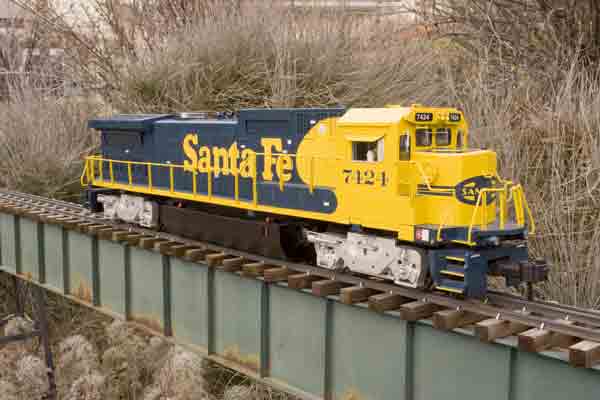
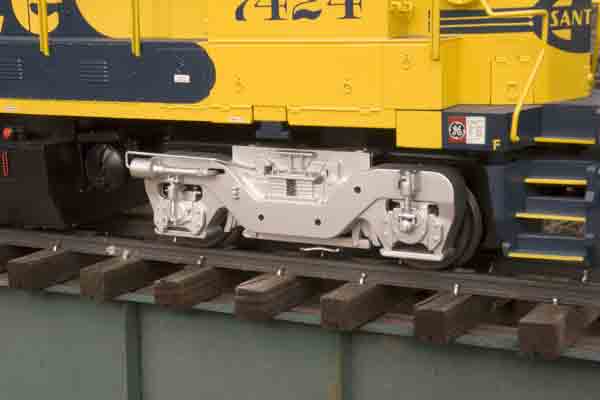
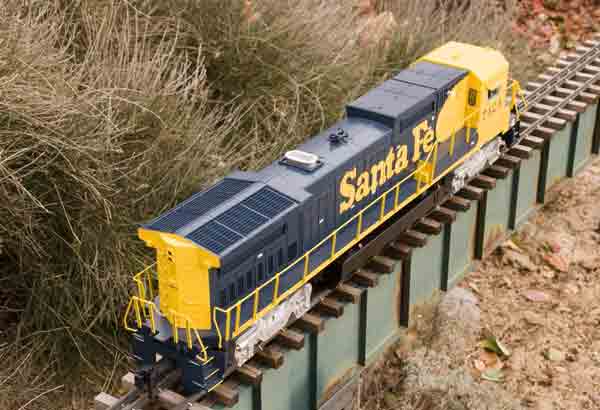
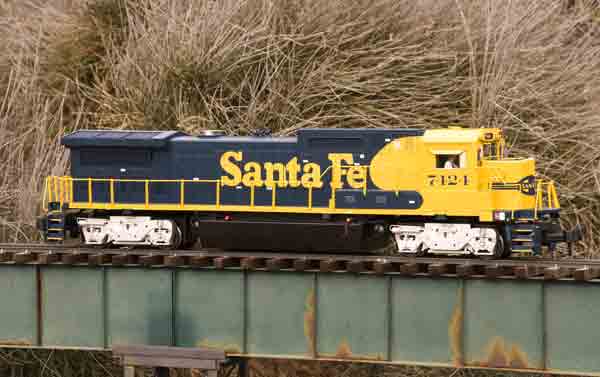
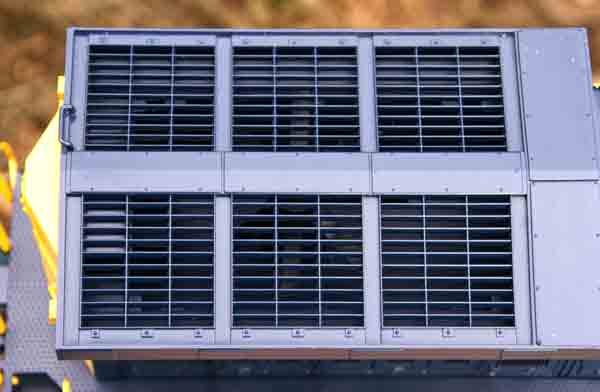









Now that I have got to know it, not so impressed. Can’t run it as I have gone down the r/c road. Why are they making a mainline Diesel that is able to go round #1 bends, I mean really!, and as for the couplings, well they are HUGE. Their own DCS system is just like Hornby with their Zero 1. Unless you open up the configuration codes for all you are doomed. Anyway probable going to try and sell it……
good article